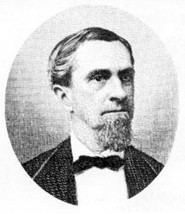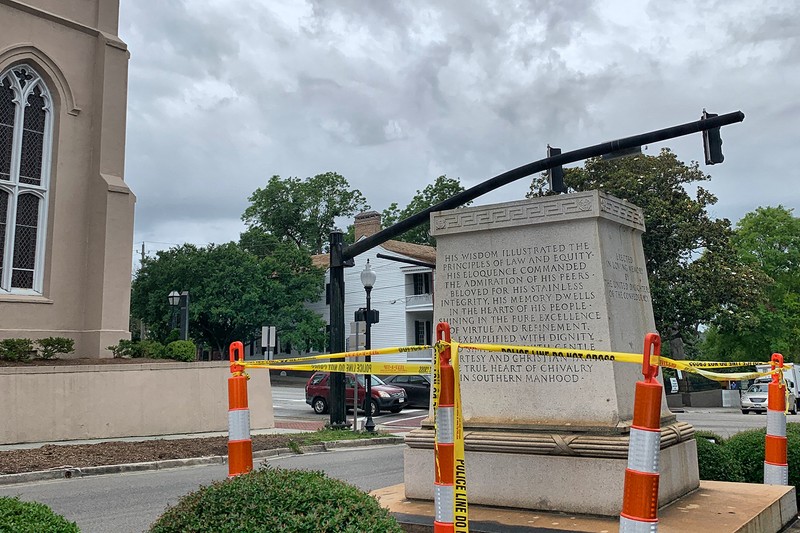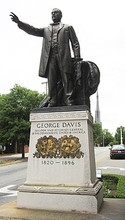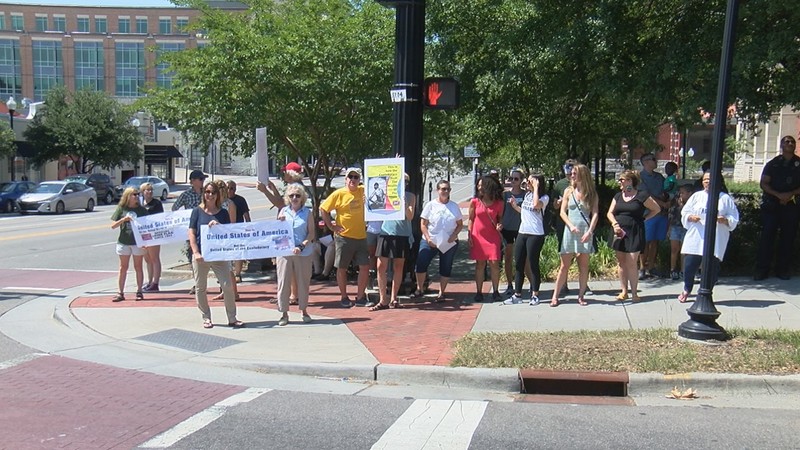George Davis Monument
Introduction
Text-to-speech Audio
Images
George Davis

Monument after George Davis had been removed.

George Davis Monument still standing.

Protestors at the George Davis Monument.

Backstory and Context
Text-to-speech Audio
Up until Thursday, June 25, 2020, the city of Wilmington, North Carolina was home to the George Davis Monument. The statue of the former Confederate politician’s monument was unveiled on April 20, 1911. Historian’s state, that along with other Confederate monuments like it, the monument is evident of the Lost Cause Narrative of the Confederacy. In addition, these monuments try to show the end of the Reconstruction era, which included the abolishment of slavery. This era was from 1865-1877 and marked a turning point for civi rights in the United States. The city of Wilmington was very clearly proud of this monument so they made sure they put it in a spot where it would be seen my everyone. It sat in a traffic island on Market Street and was seeable from Wilmington’s city hall, the New Hanover County Courthouse and the city’s oldest church. St. James Episcopal Parish. People of the city of Wilmington had a monument standing for over 100 years that signified white power and most residents probably knew this and were fine with it. Around the time that the monument was being conceived, Davis was well-liked by the "white elite" in Wilmington. So many things happened through the years surrounding this monument that it's very clear it was a celebrated part of the Wilmington resident's town. In 1993, The Sons of Confederate Veterans "George Davis Camp 5" celebrated George Davis's birthday at the monument. In 1995, descendants of Davis held at celebration at the sight. In 2000, after falling from its base because of a truck crashing into it, the George Davis monument was put on a brand new pedestal that was 6 inches higher than the last! It doesn't take a smart person to see that the residents and the officials in Wilmington had a special place for this monument.
If you want to know the monument you shall first investigate who the man George Davis was. George Davis, born on March 1, 1820 was a Confederate politician and railroad counsel. For 480 days, from 1964 to 1965 he was Attorney General of the Confederate States. He was born on a slave plantation to a father who owned slaves, so he was pretty much destined from the beginning of his life to be a racist. He went on to be the valedictorian of the 1938 Class of North Carolina University. 10 years later, he became general counsel of the Wilmington & Weldon Railroad. This was a position he held for the rest of his life and it was a prestigious one. At the beginning of his political career, Davis was a member of the Whig party. For the election of 1860 he backed the Constitutional Union Party who would go on to lose to Abraham Lincoln. George Davis then decided to be a secessionist. If you seceded, this meant that you withdrew from the Union, and this is what began the Civil War. On March 2, 1861 Davis made a speech. During the speech, he mainly went on about how North Carolina requires property of slaves. He exclaimed that without slavery, the state of North Carolina would go under. Everyone that is involved or surrounded by slavery will suffer he said. Shortly after this speech he was elected to a two-year term in the Senate. The fact that he was elected to Senate shortly after promoting slavery just shows how bigoted North Carolina was or still may be.
The Confederacy quickly began to collapse, and George Davis resigned from the fugitive party on April 25, 1865. He was by himself and planned on fleeing the country to England from Florida. On October 18, 1865 George Davis was captured in Key West, Florida and sent to prison at Fort Hamilton in Brooklyn, New York. On January 2, 1866 he was granted parole, so he was only imprisoned for a short few months. Shortly after, he accepted a delegate position for the 1866 National Union Convention. This convention was basically created to try to restart the confederate party. The goal was to create the party to support Andrew Jackson. Jackson himself was also prejudiced and advocated for white supremacy as well as not support the Reconstruction era, so it comes to no surprise that George Davis supported him. The biggest dent in Jackson's life was the Indian Removal Act. This act supported the forced removal of Indians in the United States. After the act passed, it granted the president, Andrew Jackson, the power to force Native American tribes to move to the land west of the Mississippi. After the party failed, George Davis returned to Wilmington, North Carolina, rebuilt his law practice, and continued his job as a railroad counsel. On February 23, 1896, George Davis died in the city of Wilmington. In his last ever speech in 1889, George Davis said, “My ambition went down with the banner of the South, and, like it, never rose again." Any other quote would not do a better job in explaining the Confederate politician’s life.
So 15 years after his death the City of Wilmington showed their monument of the beloved Confederate soldier. This monument was racially motivated as the idea of the sculpture came only 3 years after a group of white mobs terrorized Black residents in the Wilmington Massacre of 1898. This riot, carried out by white supremacists resulted in 14-300 deaths of Black residents. The riot began with the arson of the office of the Daily Record, a Black-owned newspaper company. The very man the monument was a Confederate leader and “hero” for crying out loud. He supported Andrew Jackson, a known white supremacist, and supported slavery.
On the bright side, the George Davis monument was finally taken away on June 25, 2020. The city claimed they removed the monument for “safety reasons.” After years of asking for it to be removed the residents were finally rewarded. The city said that recent controversy and protests lead them to determine that it is safer to go on without the statue of George Davis. The statue now resides in an undisclosed location.
Sources
Bibliography
“Commemorative Landscapes of North Carolina.” Commemorative Landscapes of North Carolina | George Davis Monument, Wilmington, 19 Mar. 2010, docsouth.unc.edu/commland/monument/112/.
“LETTERS: George Davis Statue Is a Tribute to Slavery.” Wilmington Star News, Wilmington Star News, 17 July 2019, www.starnewsonline.com/opinion/20190717/letters-george-davis-statue-is-tribute-to-slavery.
Weller, Frances. “1898 Descendants Divided on George Davis Confederate Statue.” Https://Www.wect.com, 26 Nov. 2019, www.wect.com/2019/11/26/descendants-divided-george-davis-confederate-statue/.
Smith, Blanche Lucas. North Carolina's Confederate Monuments and Memorials. North Carolina Division, United Daughters of the Confederacy, 1941.
Seabrook, Lochlainn. Confederate Monuments: Why Every American Should Honor Confederate Soldiers and Their Memorials: a Pictorial Primer. Sea Raven Press, 2018.
Campbell, Ken. “For Safety Reasons, City of Wilmington Removes Confederate Monuments.” WHQR, www.whqr.org/post/safety-reasons-city-wilmington-removes-confederate-monuments#stream/0.
“Mission Statement:” George Davis: Christian, Senator, Attorney General, www.cfhi.net/GeorgeDavisChristianSenatorAttorneyGeneral.php.
Darrough, Mark. “Momentum Gathering for Removal, Preservation of Confederate Monuments in Downtown Wilmington.” Port City Daily, 12 June 2020, portcitydaily.com/local-news/2020/06/12/momentum-gathering-for-removal-preservation-of-confederate-monuments-in-downtown-wilmington/.
Ghost. “George Davis (1820-1896), Attorney General of the Confederacy.” Commons.wikimedia.org, 22 Mar. 2007, commons.wikimedia.org/wiki/File:George_Davis.jpg.
“The Pedestal Remains, but the Statue of Confederate George Davis in Downtown Wilmington, NC, Is Removed. June 25, 2020.” News.stanford.edu, Getty Images, 25 June 2020, news.stanford.edu/2020/07/16/confederate-monuments-coming-now/.
Kelly. “ Full View of George Davis Monument, NC.” Commons.wikimedia.org, May 2009, commons.wikimedia.org/wiki/File:Georgedavis6.jpg.
Kate Cornell. “Protesters on the Corner of Market St. and 3rd. St. on June 29, 2019.” wwaytv3.Com, 29 June 2019, www.wwaytv3.com/2019/06/29/protesters-gather-at-george-davis-statue-saturday-afternoon/.
